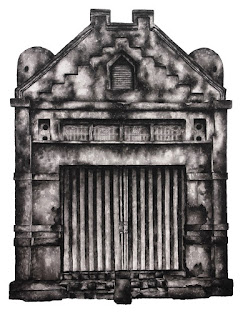KataKatha Session with Artists @ KuAsh Theatre
One audience member – likely an international school student – asked (paraphrased by this author), “if visual art is used to communicate something that one finds difficult to express in words, how do you feel when you now have to describe the completed artwork in words?” The question was directed at Agnes Arellano, Nadiah Bamadhaj, and Geraldine Kang, three artists invited to speak about their creations at “KataKatha Session with Artists”. KataKatha is a new cultural initiative sponsored by a regional bank, and run by Pusaka, whose director Eddin Khoo describes it as “…a gathering of minds and creative people, to explore the creative process, and to look at the aspects of creative life in Southeast Asia.” Its four-day program includes closed door exchanges and public sharing sessions, which documentation will be developed post-event for future exhibitions.
 |
| Nadiah Bamadhaj - Cina Wurung, Londa Durung, Jawa Tanggung (No longer Chinese, not yet a Dutchman, a half-baked Javanese) (2014) |
Nadiah opened proceedings with a wonderful recital of words, which accompanies a captivating slide show of her drawings done in the past 16 years. The 17-minutes-long presentation narrated life events that shaped subject matter choices; one notices the jagged torn-paper lines prevalent in her works (even in the older ones), as a fitting form in illustrating social imbalances. Next, Geraldine browsed through her website and casually narrated concepts behind her photographs. The first two series featuring family members shown are intensely private and intimate, which contrasts with the daring implicit in more recent public space interventions. Audacious in disposition, Geraldine’s works project an urgency to confront, a characteristic perhaps attributed to her relatively young age, or having grown up in a “cluttered” urban city-state, or both.
 |
| Geraldine Kang - picture from "This city by any other name (Would smell just as white)" series (2012 - In progress) |
Terming her sculpture installations as “inscapes”, Agnes walked the audience into her 1983 work ‘Temple to the Moon Goddess’, with random musical notes ringing in the background. Body parts are a favourite motif, and an imagined recreation of her embracing parents who died in a fire, is hauntingly beautiful. Political expressions – of social community norms, in an urban Chinese family, under one religious authority – bind these artists together, and it is precisely these concerns that resonate with us that reside in Southeast Asia. Sustainable corporate sponsorship is a tricky business, and one cannot help wonder about the neighbouring country’s not-so-secret agenda to consolidate regional art forms and procure culture for its island state. Regardless, I am optimistic, as Nadiah’s succinct response to the above question reminds, that one “…creates your own language in art.”
 |
| Installation snapshot from Agnes Arellano - Temple to the Moon Goddess (1983) |
Comments
Post a Comment